Open source AI platforms are helping humanity move toward a futuristic world faster than most anticipated.
OpenAI, Microsoft, and Google have had an outrageous month in the artificial intelligence (AI) space, and this field keeps accelerating.
What is open source AI?
Defining this term requires understanding a few others.
Open source is a software development term that means any programmer can jump in and work with it, the goal being to develop robust software in a shorter amount of time.
This is a great way to leverage the novel ideas of the best minds to fuel progress in technology. Think of open source as a group project where humanity benefits from A+ work.
Artificial Intelligence is a branch of computer science that develops programs and algorithms (step-by-step processes designed to solve a problem or answer a question) that help make various machines operate in more human-like ways.
There are several subfields of this science, including:
- Natural language processing (NLP), which focuses on developing natural interactions between humans and computers. Specialized software helps machines process human language, create understandable words, and interact with humans through language.
- Machine learning (ML), which prioritizes a machine’s ability to analyze information and use it to make recommendations or decisions based on the data sets it has provided.
- Computer vision, which is all about creating machines that can understand and then interpret visual information.
- Robotics that can physically perform tasks without human micromanagement, including interaction with humans.
Right now, companies verify we are human by having us choose photos from a set with one thing in common, such as cars or volcanoes. And if we were to see a car at the base of an active volcano, we can extrapolate that the car will be damaged. Machines are still developing these abilities.
Open source AI, then, can be defined as software engineers collaborating on various artificial intelligence projects that are open to the public to develop. The goal is to better integrate computing with humanity.
We need one last bonus keyword that helps us tie open source AI to marketing: Industry 4.0.
Industry 4.0 is the idea that advanced computing and AI have unlocked a new era in human productivity.
- The first industrial revolution was about creating machines to do work via steam or water power.
- The second industrial revolution was when we converted machines to electric power and embraced mass production. Products were built by human assembly lines, assisted by electric conveyor belts that brought the work to their hands.
- The third industrial revolution was when we plugged computers into the machinery to boost efficiency and automation. Car factories now have machines programmed to quickly and precisely build cars without human assembly lines.
- And now the fourth industrial revolution — dubbed Industry 4.0 — is about how the industry is changing now that humanity and computing are so closely interconnected. Business doesn’t just happen in boardrooms and on factory floors anymore. We carry it in our pockets.
We can sell and reinvest stocks from our kitchens at the touch of a button. Without touching anything, a voice-activated computer can order groceries, add appointments to our digital calendars, and tell us jokes as we work from home instead of commuting to an office.
It’s this new landscape, this new era in production via interconnected technologies, where open source AI for marketing comes into play.
How can marketers use AI?
AI offers a huge range of functionality to marketers who want to take the plunge, from small assists all the way up to running campaigns for you.
We’ll share some use cases to give you an idea of what’s out there.
Automated Social Posts
One of the smallest ways to leverage smart technology in marketing is to use a program that schedules and posts your pre-loaded social content.
You set the frequency (several times a day to once a month or more) and then load up all of your prepared content. It does the work for you on your own custom schedule.
Content Creation
This is an area where AI is booming. Marketers charged with creating written content have similar struggles across the industry. How do they keep coming up with ideas that will resonate with their audience? How can they produce content in less time to boost conversion?
Companies count on AI content to save the time it takes to create the body of such work, spend less on writers, and call on their experienced wordsmiths to then dial in on quality.
Personalized Emails and Data Capture
Most of us have experienced follow-up emails to the effect of, “Hey, you left an item in your cart!” or, “There’s an item on your wish list that just dropped in price!”
People cannot possibly write these billions of daily emails customized to each consumer’s shopping habits — but AI can.
Algorithms have been devised to pull user data, analyze how each customer interacts with a brand, and create personalized email content. Then, AI schedules and sends that content, all without any human interaction after it’s been set up.
Saying “Send a thank you note to Savannah” initiates an algorithm that pulls Savannah’s email address from your contact list, creates a thank you email, and splices Savannah’s name into it. The program can send it then or read the note to you, allowing you to make changes before sending.
Ad Targeting and Pay-Per-Click Campaigns
If you advertise on Google or Facebook, programs like AdWords give you deep insight and scalpel-minute details to help you gauge how your advertising campaigns are playing out. They also facilitate pay-per-click (PPC) bidding so you can efficiently allocate your ad budget.
AI can analyze who has been engaging with your ads, then redirect ad spend to groups that market research may not have anticipated. You may be delightfully surprised by how many leads you discover or conversions you gain.
Ethical Considerations Before Using Open Source AI
Nothing new comes easy. Even the highest level of technology development has important human elements that must be addressed sooner rather than later.
Biases
People write algorithms and datasets, and people have biases — whether they know the unique lenses through which they see the world or not. Those influences can and do change what a program does, especially if the AI’s output is designed to change based on human behavior in virtual spaces.
These problems become apparent when searching for bias-charged words. You’ll want to build programs that avoid stereotypes and false information.
So how can programming be less biased? This is one of the hottest topics in AI right now, and the solutions (and laws) are still being forged.
Incorrect or Incomplete Information
Just because it’s on the internet and AI finds it doesn’t mean it’s true. And just because something’s popular doesn’t mean it’s right.
Likewise, just because you have true information doesn’t mean you have the whole picture, no matter how hard you push your search engine to find the truth.
10 Top Open Source AI Platforms and Tools
Now to the main event: We’ve compiled a list of open source AI tools to introduce you to some of the best options as you wade through this topic, decide if micro AI could help boost your ROIs, or if larger open source AI projects are what you need to meet your company’s goals.
1. TensorFlow

TensorFlow is an entire support structure for programmers who want to help each other create something novel while reaping the benefits of other experts’ existing models.
TensorFlow is one of the most robust AI platforms and offers training videos to help jumpstart your success.
What we like: This platform supports several programming languages, including Swift, Python, and JavaScript — the most common programming language used on Earth.
Price: Free.
2. PyTorch
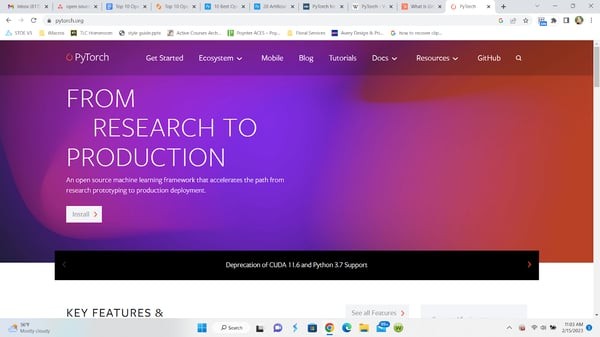
PyTorch, like TensorFlow, is a one-stop shop for transforming ideas into functional applications. It’s an entire framework created to support various aspects of open source AI project development, including vast libraries and datasets to pull from.
This platform is easy to use for developers who already code with Python. Its object-oriented approach helps bundle up usable chunks of code that do just one job.
This known and reliable “object” can then be plugged into a more extensive sequence to do a more complicated job, helping programmers help each other.
Pro tip: Programmers fluent in Python flourish here, but it also has a C++ interface for those who don’t code with Python.
Price: Free.
3. Keras

Billed as being designed for humans, Keras is an application programming interface (API) that allows you to quickly and easily share the front end of your deep learning models.
You can export your models from Keras and run them in browsers, iOS, and Android. Their Python libraries tend to focus on artificial neural networks.
Best for: Programmers who prefer a more streamlined user interface while working with the newest versions of TensorFlow, simplifying interaction with the software as it’s being built.
Price: Free.
4. OpenAI

OpenAI is all over the news, and for good reason — it’s changing the game of natural language processing (NLP) AI programs. They offer a model called Codex that changes natural language into code in the programming language you specify.
What's more, like other open source AI projects, you can access their models and customize the code yourself.
OpenAI is mastering what Alexa/Siri does and taking the next step in Industry 4.0. This AI can synthesize its own natural language answers from the information it finds instead of just pointing to a website and reading it. Incredible stuff, and you can work with it!
Price: Free $18 credit to experiment for three months, then prices are token-based and depend on what you use as you go.
5. OpenCV
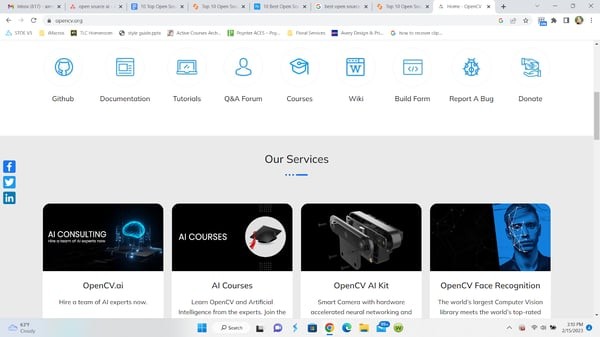
OpenCV is well-known for its open source AI platform for computer vision. If TensorFlow has an undergrad degree in general AI, OpenCV holds a master’s in AI vision.
And it works pretty much everywhere because its library was written in C, which it claims can be ported to everything from “PowerPC Macs to robotic dogs.” It includes a new C++ interface, and wrappers have been developed for Java, Python, and other languages to encourage cross-language development.
Best for: Developing AI specifically for computer vision applications.
Price: Free, including for commercial use.
6. H20.ai
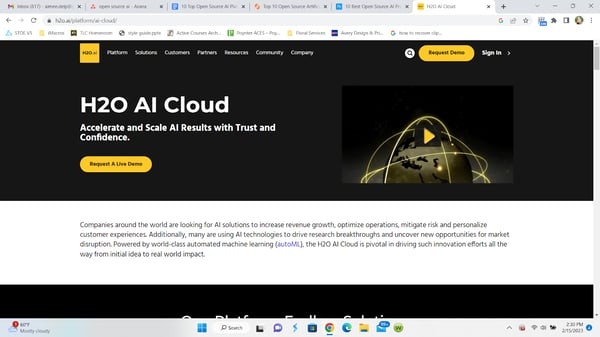
H2O.ai’s AI Cloud Platform copy claims that it is “the fastest, most accurate AI platform on the planet” and appears to be aware of ethical issues in AI.
They strive to democratize AI by making it available to anyone, empowering humanity to use it to impact the world positively.
A solid choice for: Companies that prioritize development speed and also plan to use AI to enhance their offerings, working toward streamlined AI management across the board.
Price: Free to develop open source software and to use their H20 Wave API.
7. Rasa
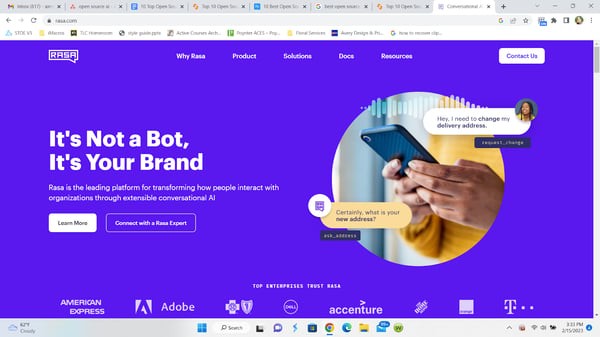
Rasa is great for building conversational AI (chatbots) and deploying it via the cloud for free. It’s flexible and touted as “future proof” because it’s been designed so you can plug any NLP or ML model into Rasa to give you increasingly accurate results as technology improves with time.
Best for: Branded conversational AI for enterprises that comes with built-in integrations for social messaging like Slack and Facebook.
Price: Free. There are also paid pro options for enterprises.
8. Amazon Web Services (AWS)
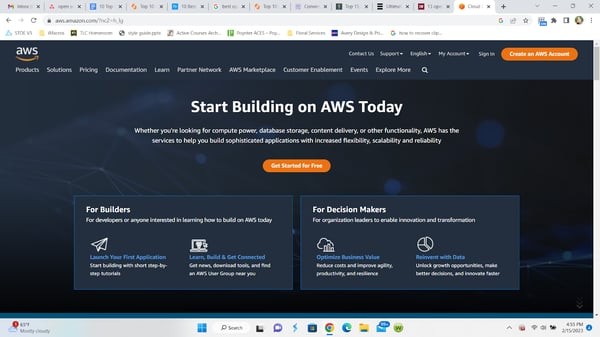
If you have code to run or want a familiar place to start building, you can do it for free on AWS/ The platform also stores the results/output of your programs.
In addition, AWS offers numerous value-added features for business marketing, such as customizing your code for their content delivery network and managing task coordination for your various cloud applications, all for free.
Best for: If you have a handle on coding but could use some support services adjacent to development — including business features to help you level up toward Industry 4.0.
Price: Costs vary. There are short-term offers, 12 months free, and always free options.
9. GitHub

Regardless of your chosen platform, the GitHub platform keeps collaborative work orderly.
GitHub is the biggest name in programming cooperation. The platform helps organize projects when many hands touch the same code, keeping track of version histories, notes, and Wikis.
Best for: Individuals or teams that don’t know each other but want to work productively on a project.
Price: Basic $0, Team $44, Enterprise $231.
GitHub AI Projects: Instagram Spam Protection & Fake Product Review Identification
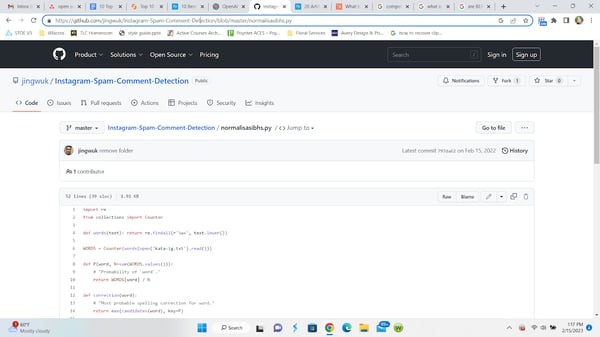
We’re including these open source AI projects in development on GitHub because so much of marketing involves moderating your social networks once content is live.
These projects allow you to pull pre-existing datasets for training your programming models to do the work more thoroughly — better protecting your brand to keep those leads rolling in.
Pro tip: Google open-sourced their ALBERT model for you to emulate. The program excels at natural language processing and is agile with language-specific issues like interpreting meanings in context.
Price: Free
The Future Unfolding Around Us
Be sure to keep your eye on the developing topic of AI. It’s happening quickly all around us.
It’s sure to be a wild ride! The cutting edge of technology always is, and AI gets sharper, smarter, faster, more enmeshed by the day.

